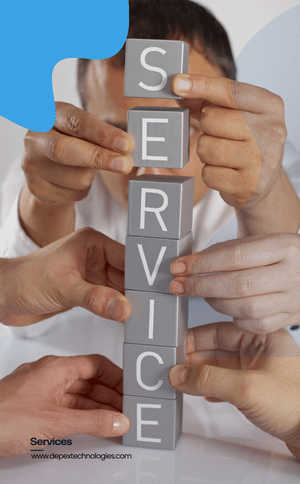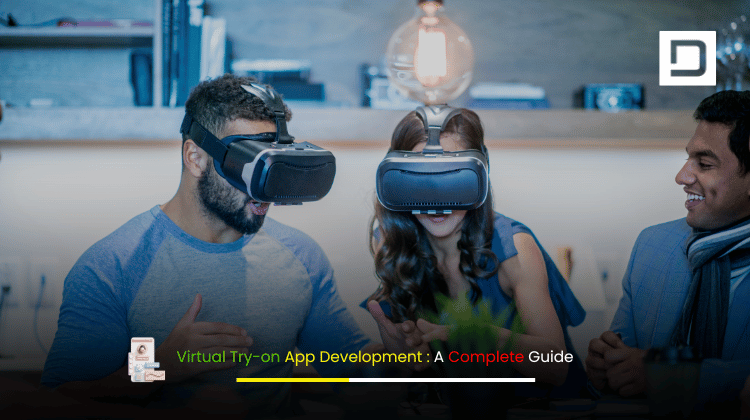Virtual Try-on App Development: A Complete Guide
The retail and e-commerce industries have witnessed a major digital transformation in recent years. One of the most revolutionary advancements has been the adoption of Virtual Try-on App Development. This innovative technology allows users to visualize how products like clothing, eyewear, jewelry, shoes, makeup, and even furniture will look on them or in their space—all from their smartphones or computers.
The global pandemic, increasing consumer demand for online experiences, and rapid advances in AR (Augmented Reality) and AI (Artificial Intelligence) have accelerated the need for interactive and personalized digital shopping solutions. Brands that invest in virtual try-on app development are setting new standards for customer engagement, satisfaction, and conversion rates.
In this complete guide, we will explore every facet of virtual try-on app development—current market landscape, types of products, business benefits, essential features, pricing, future trends, and why Depex Technologies is the ideal partner for your project.
Market Overview: Current Landscape and Future Scope
Virtual try-on solutions have rapidly moved from being a luxury or “nice-to-have” feature to a strategic necessity for forward-thinking brands. According to industry reports, the global AR in retail market size was valued at over $2 billion in 2023 and is expected to grow at a compound annual growth rate (CAGR) of more than 25% through 2030. Virtual try-on experiences are leading this surge.

Major beauty, fashion, and eyewear brands—like L’Oréal, Sephora, Warby Parker, and Gucci—have already reported higher engagement and sales after implementing virtual try-on features. These brands are leveraging immersive technology to bridge the gap between physical and digital shopping, reducing product returns and boosting buyer confidence.
Future Scope Across Product Categories
Virtual Try-on App Development is not limited to a single product vertical. Its potential stretches across multiple industries, each with unique advantages:
- Fashion and Apparel: Virtual fitting rooms let customers see clothes on themselves in real-time, increasing conversion rates and reducing returns.
- Eyewear: Shoppers can try on different glasses frames virtually, leading to quicker decisions and a more personalized experience.
- Jewelry and Accessories: Users can visualize rings, necklaces, earrings, and watches, helping them make better purchasing decisions.
- Footwear: Virtual shoe fitting apps improve confidence, fit, and style preferences.
- Cosmetics and Beauty: Try-on apps allow users to see how makeup products (lipsticks, foundations, eyeshadows) will look on their own faces, enhancing cross-selling and up-selling opportunities.
- Watches: High-end watch brands use AR try-on features to create premium experiences.
- Furniture and Home Decor: Customers can place virtual furniture in their homes to check size, fit, and style before purchasing.
As AR and AI technologies mature, virtual try-on app development is expected to play a significant role in automotive, luxury goods, healthcare (e.g., prosthetics, dental), and even the travel industry.
Why Brands Are Investing in Virtual Try-on App Development
The shift toward online and mobile shopping has made customer engagement more challenging and competitive. Virtual try-on technology addresses some of the biggest hurdles in digital commerce:
Enhanced Customer Experience
Consumers crave personalized and interactive experiences. Virtual try-on apps allow them to experiment with different products, styles, and looks—right from the comfort of their homes. This not only builds excitement but also creates a memorable shopping journey that differentiates your brand.
Improved Conversion Rates
When shoppers can visualize products on themselves, their likelihood of purchasing increases dramatically. Brands have reported up to 30–40% higher conversion rates after implementing virtual try-on features.
Reduced Product Returns
One of the most significant benefits of Virtual Try-on App Development is the dramatic reduction in returns. Since users can virtually “test” the fit, color, and style, they make more informed decisions, leading to fewer post-purchase regrets.
Greater Reach and Accessibility
Virtual try-on apps break down the barriers of location and store timings. Shoppers from anywhere in the world can engage with your products, try them on, and buy with confidence—24/7.
Data-Driven Insights
These apps collect valuable data on customer preferences, styles, and behaviors. Brands can leverage these insights to optimize inventory, personalize marketing campaigns, and create better products.
Brand Loyalty and Engagement
A delightful digital experience creates brand advocates. Satisfied customers are more likely to return and recommend your brand to others.
Cost of Virtual Try-on App Development: Detailed Breakdown
One of the most common questions is: How much does it cost to develop a virtual try-on app?
The price for professional Virtual Try-on App Development typically ranges from $49,999 to $200,000. Several factors influence the final cost, including complexity, technology stack, platform choices, and feature set.
Key Cost Drivers
- Type of Virtual Try-on Experience
- 2D overlays vs. real-time 3D AR try-ons: 3D and AR solutions require more advanced technology and higher investment.
- Product Catalog Size
- Apps with large, frequently updated catalogs (clothing, eyewear, shoes) require robust backend and efficient image/model processing.
- Supported Platforms
- iOS, Android, and Web apps: Building for multiple platforms increases the cost, especially if native development is required.
- AR & AI Technology
- Integration of AR SDKs (ARKit, ARCore), facial or object recognition, and machine learning models adds complexity and expense.
- Custom UI/UX Design
- Creating intuitive, visually appealing interfaces tailored for virtual try-on is crucial for user adoption.
- Backend Infrastructure
- Cloud hosting, real-time data sync, analytics, and security.
- Third-party Integrations
- Payment gateways, e-commerce platforms (Shopify, Magento), CRM, analytics tools.
- Testing and Quality Assurance
- Rigorous testing across devices and environments to ensure accuracy and performance.
- Post-launch Support and Updates
- Ongoing maintenance, feature enhancements, and bug fixes.
Typical Budget Range:
- Basic MVP (Minimal Viable Product): $49,999–$75,000
- Mid-level Feature-rich App: $75,000–$120,000
- Enterprise-grade Solution: $120,000–$200,000
It’s important to work with an experienced development partner like Depex Technologies to scope your project correctly and maximize your ROI.
Must-Have Features for a Virtual Try-on App
For a virtual try-on app to succeed, it should offer a seamless and delightful experience to users. Here are the key features to include in your Virtual Try-on App Development project:
User-Friendly Onboarding
A smooth sign-up and onboarding process is critical. New users should be able to quickly understand how to use the app and access its core features.
High-Quality Camera Integration
The app should have flawless camera integration for real-time AR try-on experiences, supporting both front and rear cameras with smart switching.
Product Catalog and Filtering
Users should be able to browse, search, and filter products easily by categories, style, color, size, and more.
Real-Time AR Try-on
This is the heart of virtual try-on app development. Leverage AR technology to allow users to “wear” products virtually—be it clothes, glasses, shoes, or jewelry.
Advanced facial and body tracking ensures products fit and move naturally with the user.
3D Model Rendering
For an immersive experience, the app must support high-quality 3D models of your products. The rendering should be smooth, realistic, and fast.
Face and Body Detection
Using AI and machine learning, the app should accurately detect and map users’ faces or bodies to ensure virtual products align correctly.
Style Recommendations and Personalization
Enhance engagement with AI-powered style suggestions, virtual stylists, or lookbooks based on user preferences and behavior.
Social Sharing
Let users share their try-on images or videos directly on social media platforms, amplifying word-of-mouth marketing for your brand.
Wishlist and Favorites
Allow users to save their favorite products, creating a personalized shopping experience and increasing the chances of conversion.
Virtual Shopping Cart and Secure Payments
Integrate a shopping cart, multiple payment options, and a secure checkout process for instant purchasing.
Analytics and Admin Dashboard
A robust backend allows you to track user behavior, product performance, sales, and engagement. Insights from analytics help in continuous improvement.
Multi-language and Multi-currency Support
For global brands, supporting various languages and currencies improves accessibility and boosts international sales.
Customer Support Integration
Chatbots, FAQs, and live chat ensure users get instant help whenever they have questions.
The Development Process: Step-by-Step
At Depex Technologies, we follow a strategic and transparent process for Virtual Try-on App Development. Here’s how we deliver world-class apps:
Discovery and Planning
We start by understanding your business, target audience, products, and goals. A detailed analysis helps us define the app’s core features, technology stack, and project scope.
UX/UI Design
Our expert designers create intuitive wireframes and beautiful UI mockups. We focus on user experience, ensuring the app is both attractive and easy to use.
Technology Selection
Choosing the right AR SDKs, AI frameworks, and backend solutions is crucial. We recommend technologies based on scalability, budget, and performance.

App Development
Our skilled developers bring the design to life, integrating AR, AI, and e-commerce functionalities. We ensure seamless performance across all devices and platforms.
Quality Assurance
Rigorous testing is conducted for usability, speed, accuracy of AR overlays, and security. We test on various devices and network conditions to ensure optimal performance.
Launch and Deployment
After approval, we assist you with app store submissions, deployment to web or cloud, and go-live support.
Post-launch Support
Our relationship doesn’t end at launch. We offer ongoing maintenance, feature updates, and performance monitoring to keep your app ahead of the competition.
Technology Stack for Virtual Try-on App Development
Selecting the right technology stack is essential for a scalable and future-ready virtual try-on app. Here’s a quick overview:
- Frontend: React Native, Flutter, Swift (iOS), Kotlin (Android)
- Backend: Node.js, Python (Django/Flask), Java, Ruby on Rails
- AR SDKs: ARKit (iOS), ARCore (Android), Vuforia, Unity, Spark AR, WebXR for browsers
- AI & ML: TensorFlow, PyTorch, OpenCV for facial/body recognition and personalization
- Cloud and Storage: AWS, Google Cloud, Microsoft Azure
- Analytics: Google Analytics, Mixpanel, custom dashboards
- Payment Integration: Stripe, PayPal, Razorpay, Apple Pay, Google Pay
- Security: SSL/TLS, GDPR compliance, data encryption
Our team at Depex Technologies helps you navigate these choices and select the optimal stack for your budget and vision.
Real-World Success Stories
Let’s look at a few brands that have leveraged virtual try-on app development to revolutionize customer experience:
- L’Oréal Paris: Their AR-powered “ModiFace” app allows users to try on makeup products virtually. It contributed to a significant increase in online makeup sales and reduced return rates.
- Warby Parker: The eyewear giant’s virtual try-on feature lets customers see themselves in hundreds of frames, making buying glasses online easier and more fun.
- Nike: The “Nike Fit” app uses AR to scan users’ feet and recommend the best shoe size, reducing size-related returns.
- IKEA Place: Shoppers can place virtual furniture in their homes to check fit and style, improving confidence in large purchases.
These brands demonstrate the ROI and brand value that virtual try-on app development can deliver.
Challenges and Solutions in Virtual Try-on App Development
Accurate Product Visualization
Challenge: Achieving realistic overlays that match users’ facial features, body types, and skin tones is technically demanding.
Solution: Advanced machine learning algorithms and 3D modeling are used to ensure virtual products look natural and true to life.
Device and Platform Fragmentation
Challenge: Ensuring flawless performance across the vast range of devices and operating systems can be challenging.
Solution: Thorough testing and leveraging cross-platform development tools help deliver a consistent experience.
Privacy and Data Security
Challenge: Handling sensitive user data, including images and personal preferences, requires strict data protection.
Solution: Implementing end-to-end encryption, GDPR compliance, and robust security protocols is essential.
Scalability
Challenge: As product catalogs and user bases grow, the app’s infrastructure must be scalable and reliable.
Solution: Cloud-based architectures, microservices, and efficient database design allow for seamless scaling.
Depex Technologies has proven expertise in solving these challenges, ensuring your virtual try-on app is robust, secure, and future-proof.
Future Trends in Virtual Try-on App Development
Virtual Try-on App Development is rapidly evolving. Staying ahead of the curve ensures your business reaps the benefits of emerging trends:
- Hyper-Personalization: AI will further refine recommendations based on individual preferences, past purchases, and even mood.
- Mixed Reality Shopping: Integration of AR with VR and MR (Mixed Reality) will deliver even more immersive experiences.
- Social Commerce: Shoppable social media integrations will allow users to purchase products directly from influencer try-on posts.
- Metaverse Integration: Brands will create virtual stores and avatars, letting users try and buy products in virtual worlds.
- AI-powered Size and Fit Prediction: Advanced algorithms will make recommendations for fit and sizing based on user-uploaded images and data, minimizing returns.
- Sustainability: Virtual try-on helps brands reduce the need for physical samples and product waste.
As consumer expectations rise, investing in innovative virtual try-on technology now positions your brand for long-term growth and leadership.
Why Choose Depex Technologies for Virtual Try-on App Development?
At Depex Technologies, we understand that your virtual try-on app is not just another tool—it’s a critical part of your customer journey and brand story. Here’s what sets us apart:
- Proven Experience: We have delivered successful AR and AI-powered apps for clients worldwide.
- End-to-End Solutions: From concept to launch and beyond, we manage every aspect of your app development.
- Cutting-Edge Technology: Our team stays updated with the latest in AR, AI, and e-commerce integrations.
- Custom Approach: We tailor solutions to fit your industry, product range, and business goals.
- Transparent Communication: You get clear timelines, regular updates, and collaborative decision-making.
- Competitive Pricing: Our solutions are designed for maximum ROI, with pricing that’s fair and transparent.
Conclusion: Ready to Transform Your Customer Experience?
Virtual try-on app development is more than a trend—it’s the future of retail and digital commerce. Whether you’re in fashion, beauty, eyewear, jewelry, footwear, or home decor, adopting this technology will set you apart from competitors, increase conversions, and delight your customers.
The cost to develop a virtual try-on app ranges from $49,999 to $200,000, depending on your needs and ambitions. By partnering with Depex Technologies, you gain access to a world-class team, proven process, and innovative technology—ensuring your project’s success from day one.

Don’t get left behind as the digital shopping revolution accelerates. Contact Depex Technologies today to discuss your virtual try-on app development project. Let’s build a seamless, engaging, and profitable AR shopping experience together.






